Enhancing Wireless Charging for Electric Vehicles: Active Load Impedance Matching and Its Impact on Efficiency, Cost and Size
Abstract
:1. Introduction
- Efficiency at Low Operational Frequencies: Achieving better efficiency at frequencies below 10 kHz, allowing the use of standard plain copper wire instead of Litz wire in WPT inductors.
- Loss Distribution: Improved loss distribution in the system, reducing cooling system costs and facilitating integration [15].
- Partial Compensation for Misalignment: Partially compensates for the detuning of the compensation circuit caused by vehicle misalignment, thereby reducing performance loss [16].
2. Compensation Circuit
3. Operation Frequency
4. Load Impedance Matching
4.1. Introduction
4.2. Load Impedance Matching with Synchronous Rectification
4.3. Rectification with Active Load Impedance Matching (ALIM) Strategy
4.4. Control Law
5. Application Case: 800 V 11 kW 7 kHz Bidirectional Wireless Charger
5.1. Product Definition
- Nominal battery voltage at 800 V. Full range is [300–900 V];
- Supply DC voltage at 800 V;
- Maximum charging power: 11 kW;
- Maximum V2X power: 11 kW;
- Maximum EV coil diameter: 400 mm;
- Maximum charging station coil diameter: 450 mm;
- Nominal coil-to-coil airgap: 100 mm.
5.2. Sizing Results
5.3. Overall Performances
5.4. Sensitivity to Parameter Drift
6. Operational Performances on Electric Vehicle Mockup: 350 V 7 kW 3 kHz Bidirectional Wireless Charger
7. Application Case: 800 V 11 kW 85 kHz Bidirectional Wireless Charger
7.1. Circuit Definition and Driving Strategy
7.2. Product Definition
7.3. Sizing Results
8. Conclusions
Funding
Data Availability Statement
Conflicts of Interest
References
- Kashani, S.A.; Soleimani, A.; Khosravi, A.; Mirsalim, M. State-of-the-Art Research on Wireless Charging of Electric Vehicles Using Solar Energy. Energies 2022, 16, 282. [Google Scholar] [CrossRef]
- Eltamaly, A.M. Optimal Dispatch Strategy for Electric Vehicles in V2G Applications. Smart Cities 2023, 6, 3161–3191. [Google Scholar] [CrossRef]
- Fotopoulou, M.; Rakopoulos, D.; Blanas, O. Day Ahead Optimal Dispatch Schedule in a Smart Grid Containing Distributed Energy Resources and Electric Vehicles. Sensors 2021, 21, 7295. [Google Scholar] [CrossRef] [PubMed]
- Bian, H.; Ren, Q.; Guo, Z.; Zhou, C. Optimal Scheduling of Integrated Energy System Considering Electric Vehicle Battery Swapping Station and Multiple Uncertainties. World Electr. Veh. J. 2024, 15, 170. [Google Scholar] [CrossRef]
- Palani, G.; Sengamalai, U.; Vishnuram, P.; Nastasi, B. Challenges and Barriers of Wireless Charging Technologies for Electric Vehicles. Energies 2023, 16, 2138. [Google Scholar] [CrossRef]
- SAE Standard J2954; SAE J2954 Wireless Power Transfer for Light-Duty Plug-In/Electric Vehicles and Alignment Methodology. SAE International: Warrendale, PA, USA, 2020.
- Lee, T.-E.; Huang, T.-H. Hybrid Impedance Matching Strategy for Wireless Charging System. In Proceedings of the 2016 IEEE Vehicle Power and Propulsion Conference (VPPC), Hangzhou, China, 17–20 October 2016. [Google Scholar]
- Yang, H.; Wu, C.; Chen, T. Efficiency Improvement for Wireless Power Transfer System via a Nonlinear Resistance Matching Network. Electronics 2023, 12, 1341. [Google Scholar] [CrossRef]
- Xu, Y.; Zhang, Y.; Wu, T. Wireless Power Transfer Efficiency Optimization Tracking Method Based on Full Current Mode Impedance Matching. Sensors 2024, 24, 2917. [Google Scholar] [CrossRef] [PubMed]
- Sun, Z.; Hu, G.; Wang, Y.; Guan, Y.; Xu, D. Analysis and Design of Configurable Rectifier with Compensated Near-Zero Impedance Angle for Megahertz Wireless Power Transfer. IEEE Trans. Ind. Electron. 2024, 71, 4596–4606. [Google Scholar] [CrossRef]
- Bentalhik, I.; Lassioui, A.; EL Fadil, H.; Bouanou, T.; Rachid, A.; EL Idrissi, Z.; Hamed, A.M. Analysis, Design and Realization of a Wireless Power Transfer Charger for Electric Vehicles: Theoretical Approach and Experimental Results. World Electr. Veh. J. 2022, 13, 121. [Google Scholar] [CrossRef]
- Waldron, J.; Rodrigues, L.; Deb, S.; Gillott, M.; Naylor, S.; Rimmer, C. Exploring Opportunities for Vehicle-to-Grid Implementation through Demonstration Projects. Energies 2024, 17, 1549. [Google Scholar] [CrossRef]
- Osawa, J. Evaluation of Technological Configurations of Residential Energy Systems Considering Bidirectional Power Supply by Vehicles in Japan. Energies 2024, 17, 1574. [Google Scholar] [CrossRef]
- Sullivan, C. Cost-constrained selection of strand diameter and number in a litz-wire transformer winding. IEEE Trans. Power Electron. 2001, 16, 281–288. [Google Scholar] [CrossRef]
- Sabki, S.A.; Tan, N.M.L. Wireless power transfer for electric vehicle. In Proceedings of the 2014 IEEE 8th International Power Engineering and Optimization Conference (PEOCO2014), Langkawi, Malaysia, 24–25 March 2014; pp. 41–46. [Google Scholar]
- Wen, H.; Wang, P.; Li, J.; Yang, J.; Zhang, K.; Yang, L.; Zhao, Y.; Tong, X. Improving the Misalignment Tolerance of Wireless Power Transfer System for AUV with Solenoid-Dual Combined Planar Magnetic Coupler. J. Mar. Sci. Eng. 2023, 11, 1571. [Google Scholar] [CrossRef]
- Venkatesan, M.; Rajamanickam, N.; Vishnuram, P.; Bajaj, M.; Blazek, V.; Prokop, L.; Misak, S. A Review of Compensation Topologies and Control Techniques of Bidirectional Wireless Power Transfer Systems for Electric Vehicle Applications. Energies 2022, 15, 7816. [Google Scholar] [CrossRef]
- Shu, X.; Wu, G.; Jiang, Y. Comparative Analysis of SS, SP, PP and PS Topologies for Magnetic Coupled Wireless Power Transfer System Composed of the Negative Resistor. Energies 2023, 16, 7336. [Google Scholar] [CrossRef]
- Feng, H.; Wang, D. Minimizing Material Usage for Efficient and Compact Coil in Wireless Charging System of Electric Vehicles. IEEE Trans. Transp. Electrif. 2023, 10, 2886–2898. [Google Scholar] [CrossRef]
- Sha, L.; Liu, J.; Chen, Z. Research on Evaluation Method of Electric Vehicle Wireless Charging Interoperability Based on Two Parameter Representation. Processes 2022, 10, 1591. [Google Scholar] [CrossRef]
- Liu, W.; Hu, C.; Xiang, L. A Multimodal Modulation Scheme for Electric Vehicles’ Wireless Power Transfer Systems, Based on Secondary Impedance. Electronics 2022, 11, 3055. [Google Scholar] [CrossRef]
- Oeder, C.; Duerbaum, T. ZVS investigation of llc converters based on FHA assumptions. In Proceedings of the 2013 Twenty-Eighth Annual IEEE Applied Power Electronics Conference and Exposition (APEC), Long Beach, CA, USA, 17–21 March 2013; pp. 2643–2648. [Google Scholar]
- Sucameli, M.; Adragna, C. LLC Resonant Converters as Isolated Power Factor Corrector Pre-Regulators—Analysis and Performance Evaluation. Energies 2023, 16, 7114. [Google Scholar] [CrossRef]
- Steigerwald, R.L. A comparison of half-bridge resonant converter topologies. In Proceedings of the 1987 2nd IEEE Applied Power Electronics Conference and Exposition, San Diego, CA, USA, 2–6 March 1987; pp. 135–144. [Google Scholar]
- Zhou, X.; Wang, J.; Yang, L. A Light-Load Efficiency Improvement Technique for an Inductive Power Transfer System through a Reconfigurable Circuit. Energies 2024, 17, 3024. [Google Scholar] [CrossRef]
- El Baghdadi, M.; Benomar, Y.; Hegazy, O.; Yang, Y.; Van Mierlo, J. Design approach and interoperability analysis of wireless power transfer systems for vehicular applications. In Proceedings of the 2016 18th European Conference on Power Electronics and Applications (EPE’16 ECCE Europe), Karlsruhe, Germany, 5–9 September 2016; pp. 1–11. [Google Scholar]
- Jimoh, B.A.; Roşu, Ş.-G. Single-Phase AC-DC PFC Converters for EV Chargers: An Overview. In Proceedings of the 2023 15th International Conference on Electronics, Computers and Artificial Intelligence (ECAI), Bucharest, Romania, 29–30 June 2023; pp. 1–6. [Google Scholar]
- Nisch, A.; Kloeffer, C.; Weigold, J.; Wondrak, W.; Schweikert, C.; Beaurenaut, L. Effects of a SiC TMOSFET Tractions Inverters on the Electric Vehicle Drivetrain. In Proceedings of the PCIM Europe 2018; International Exhibition and Conference for Power Electronics, Intelligent Motion, Renewable Energy and Energy Management, Nuremberg, Germany, 5–7 June 2018; pp. 1–8. [Google Scholar]
- Campi, T.; Cruciani, S.; Maradei, F.; Feliziani, M. Magnetic Field during Wireless Charging in an Electric Vehicle According to Standard SAE J2954. Energies 2019, 12, 1795. [Google Scholar] [CrossRef]
- Lv, C.; Liu, J.; Zhang, Y.; Yin, J.; Cao, R.; Li, Y.; Liu, X. A Method to Characterize the Shrinking of Safe Operation Area of Metallized Film Capacitor Considering Electrothermal Coupling and Aging in Power Electronics Applications. IEEE Trans. Ind. Electron. 2022, 70, 1993–2002. [Google Scholar] [CrossRef]
- Li, W.; Diao, L.; Mei, W.; Dongye, Z.; Qin, X.; Jin, Z. Optimized Resonant Network Design for High Energy Transfer Efficiency of the WPT System. Electronics 2023, 12, 1984. [Google Scholar] [CrossRef]
- Huang, L.; Yao, W.; Lu, Z. Interleaved totem-pole bridgeless PFC rectifier with ZVS and low input current ripple. In Proceedings of the 2015 IEEE Energy Conversion Congress and Exposition (ECCE), Montreal, QC, Canada, 20–24 September 2015; pp. 166–171. [Google Scholar]
- Yang, L.; Xu, L.; Yang, T.; Zhang, B. Class D Power Amplifier for Audio Beam System. In Proceedings of the 2007 International Conference on Mechatronics and Automation, Harbin, China, 5–8 August 2007; pp. 3469–3474. [Google Scholar]
- Kawahara, S.; Umetani, K.; Hiraki, E. AC resistance Prediction of Litz Wire Planer Spiral Coil Based on Litz wire Loss Model. In Proceedings of the 2020 23rd International Conference on Electrical Machines and Systems (ICEMS), Hamamatsu, Japan, 24–27 November 2020; pp. 1541–1546. [Google Scholar]
- Zimoch, P.; Kasprzak, M.; Kierepka, K. Influence of MOSFET Parasitic Capacitance on the Operation of Interleaved ZVS Boost Converters. Energies 2020, 13, 6130. [Google Scholar] [CrossRef]

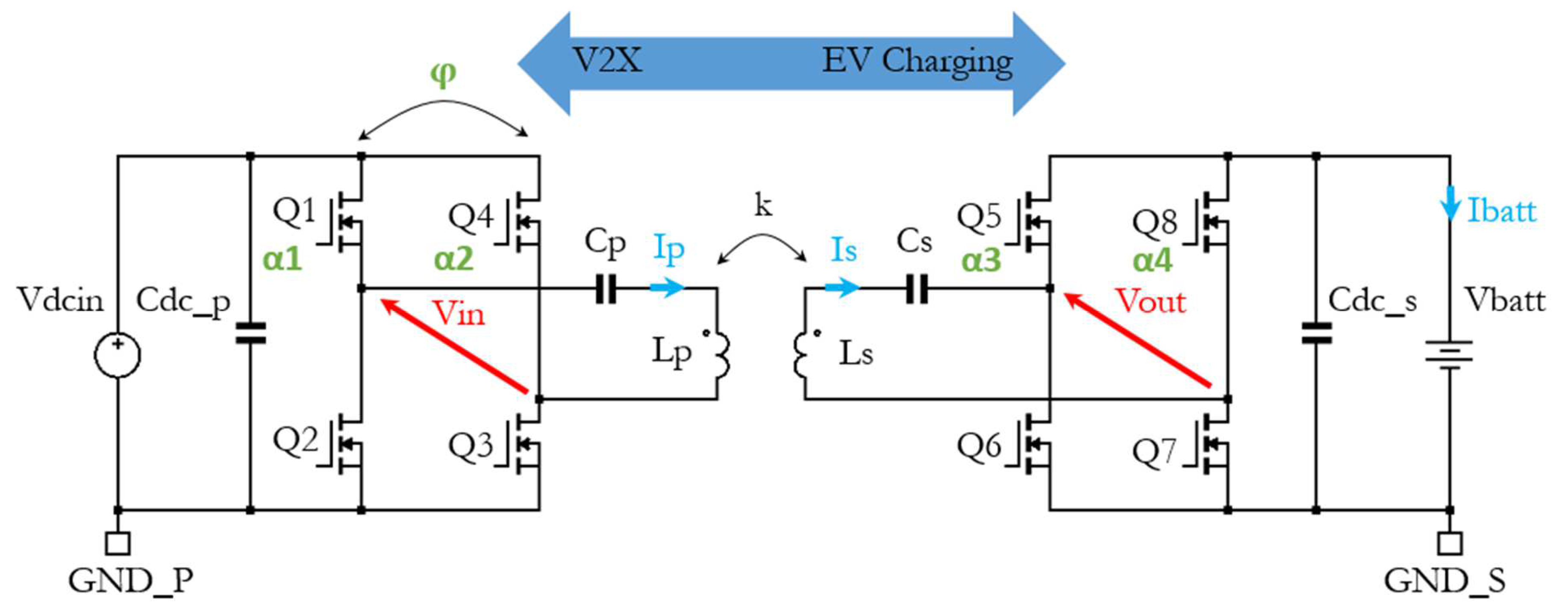


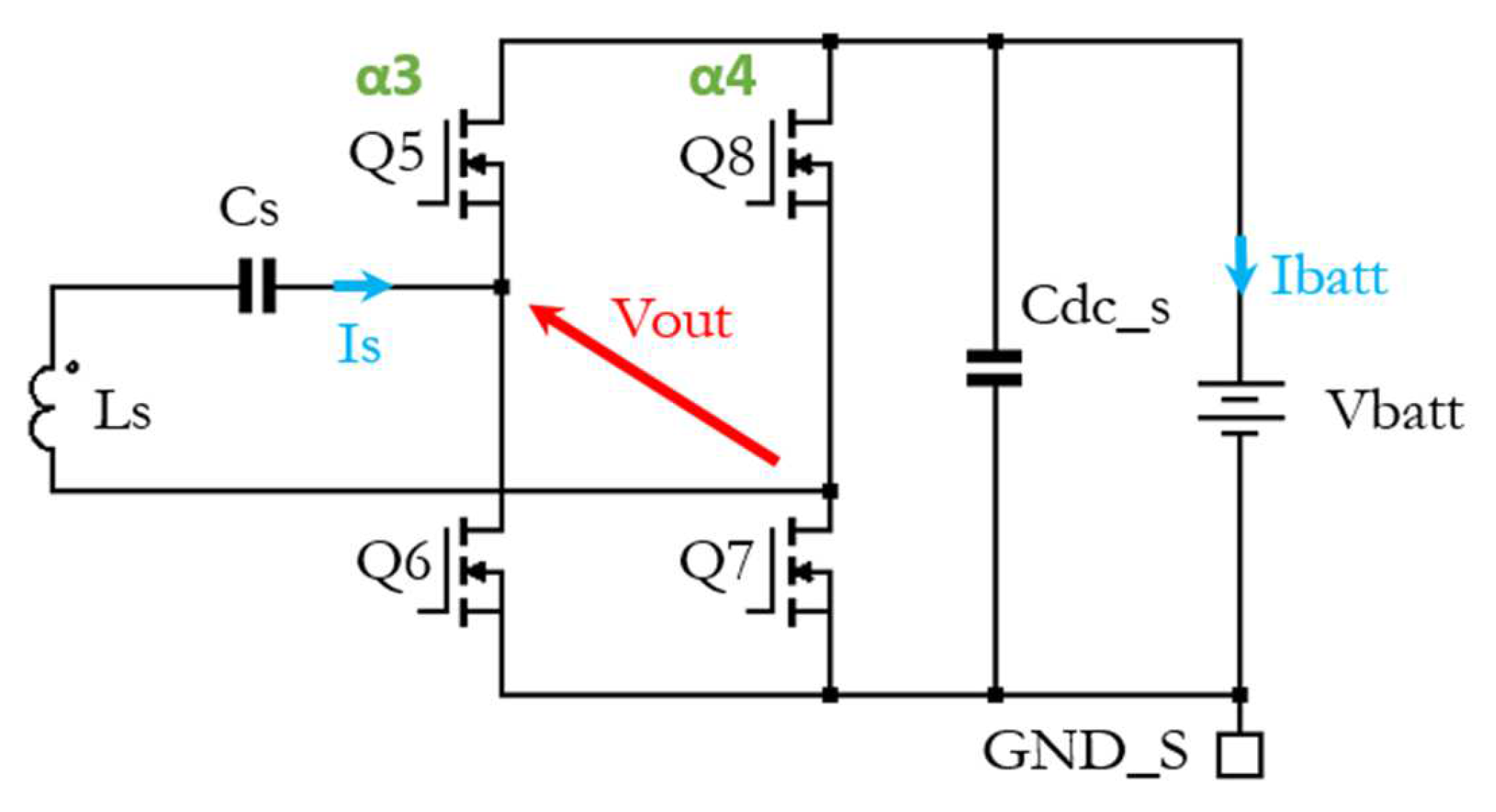

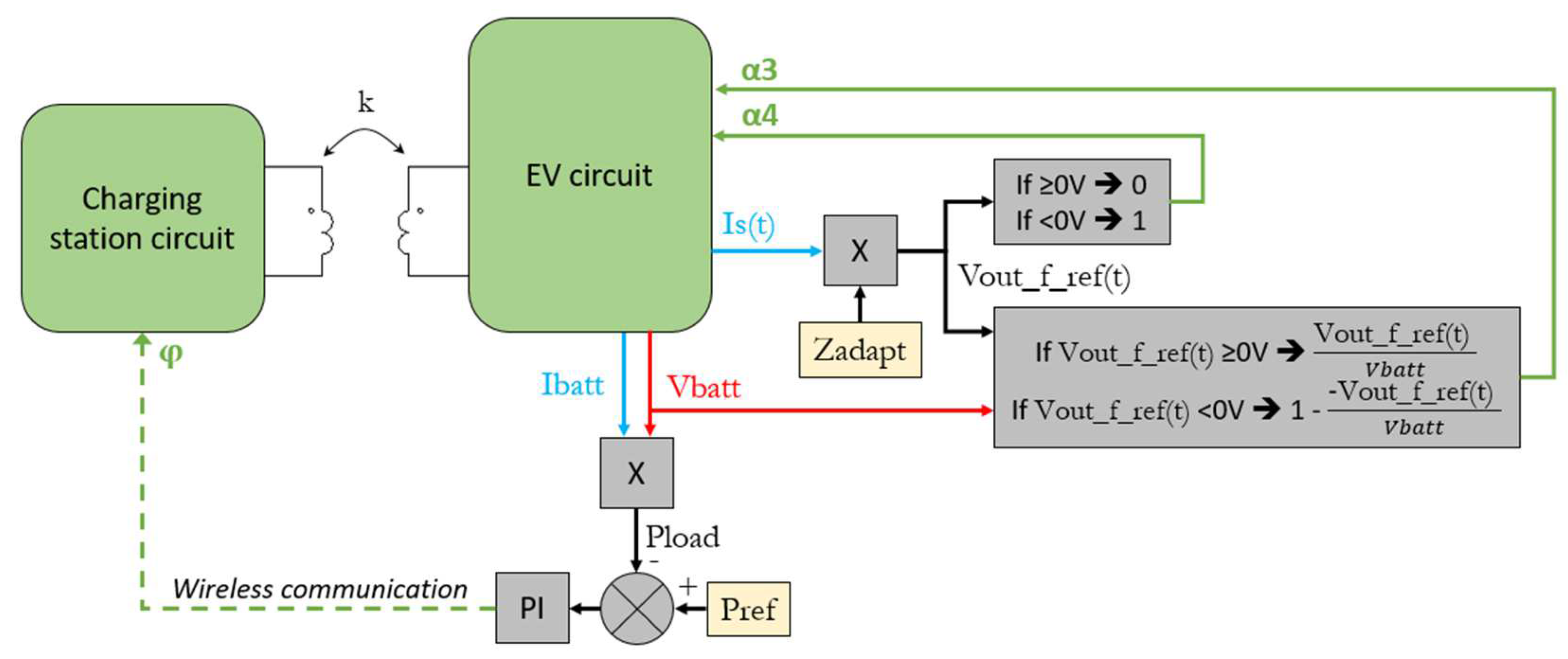
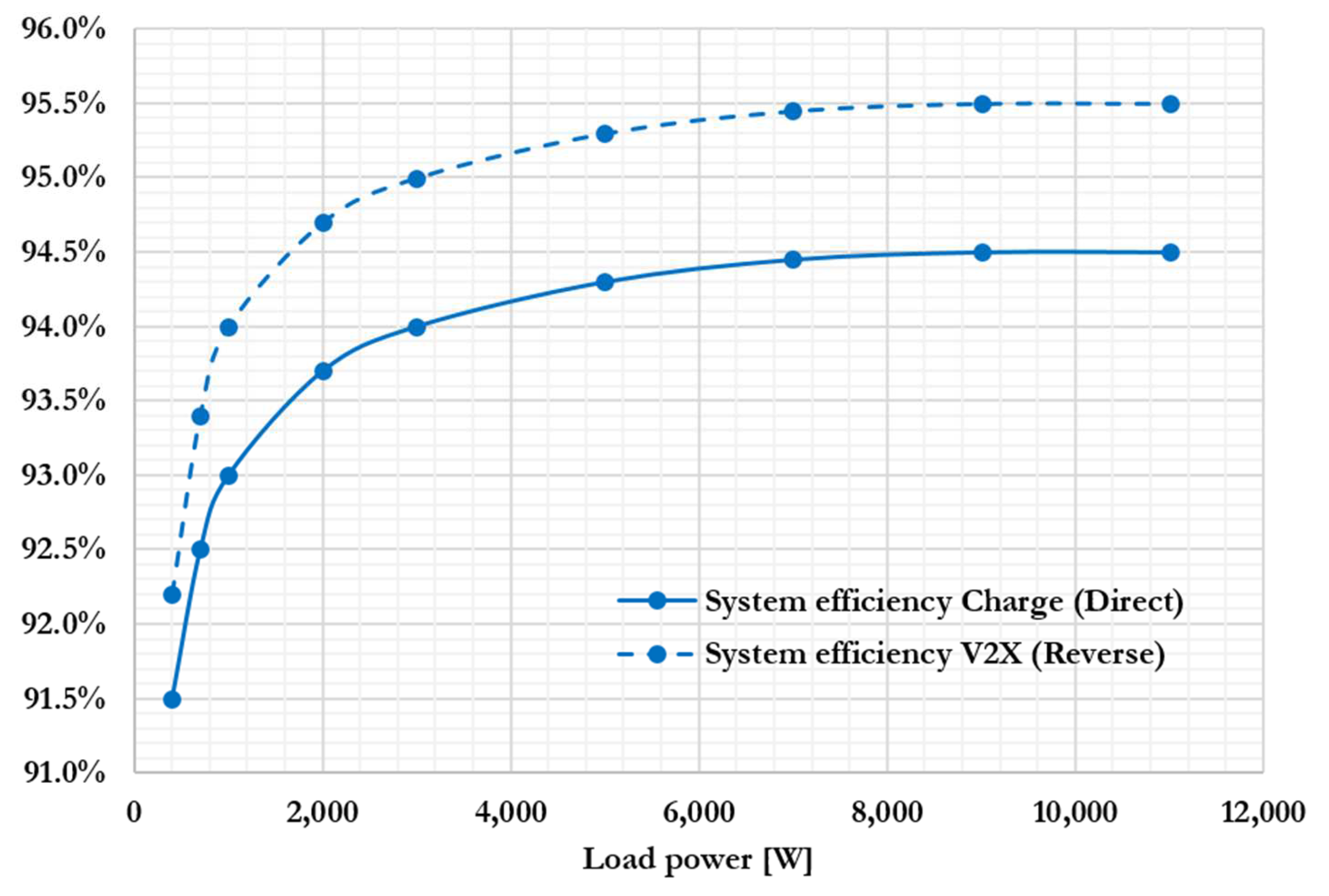

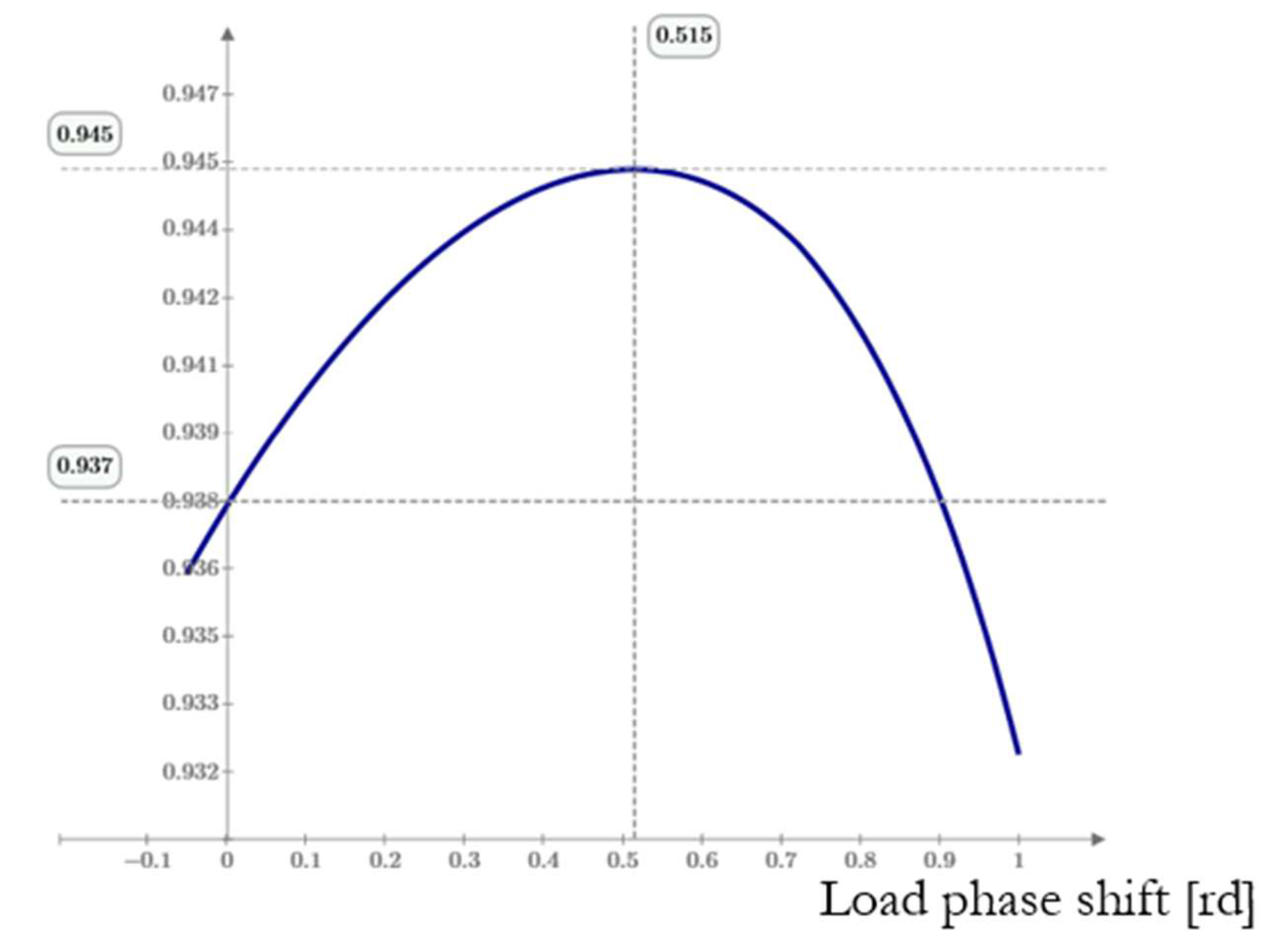
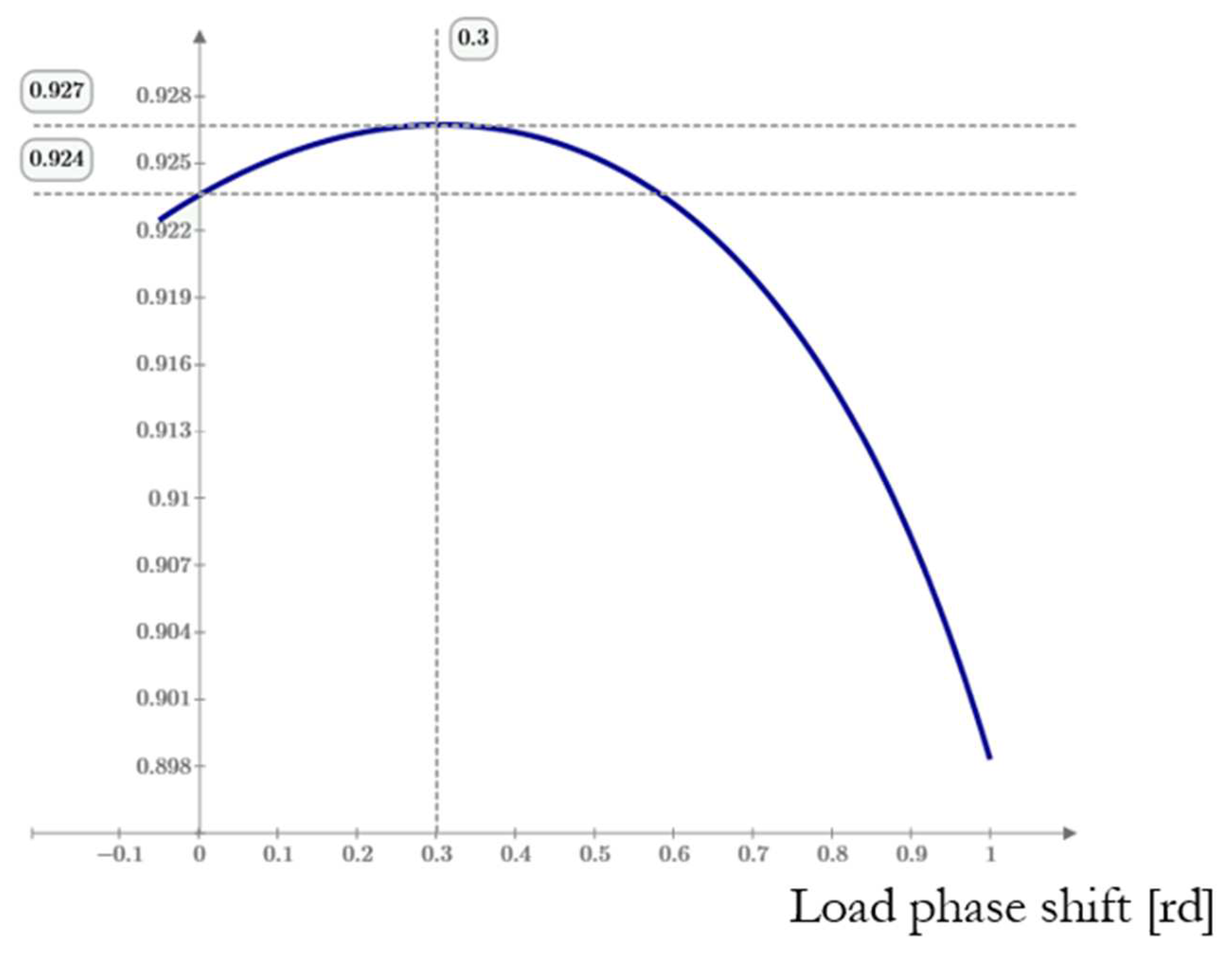
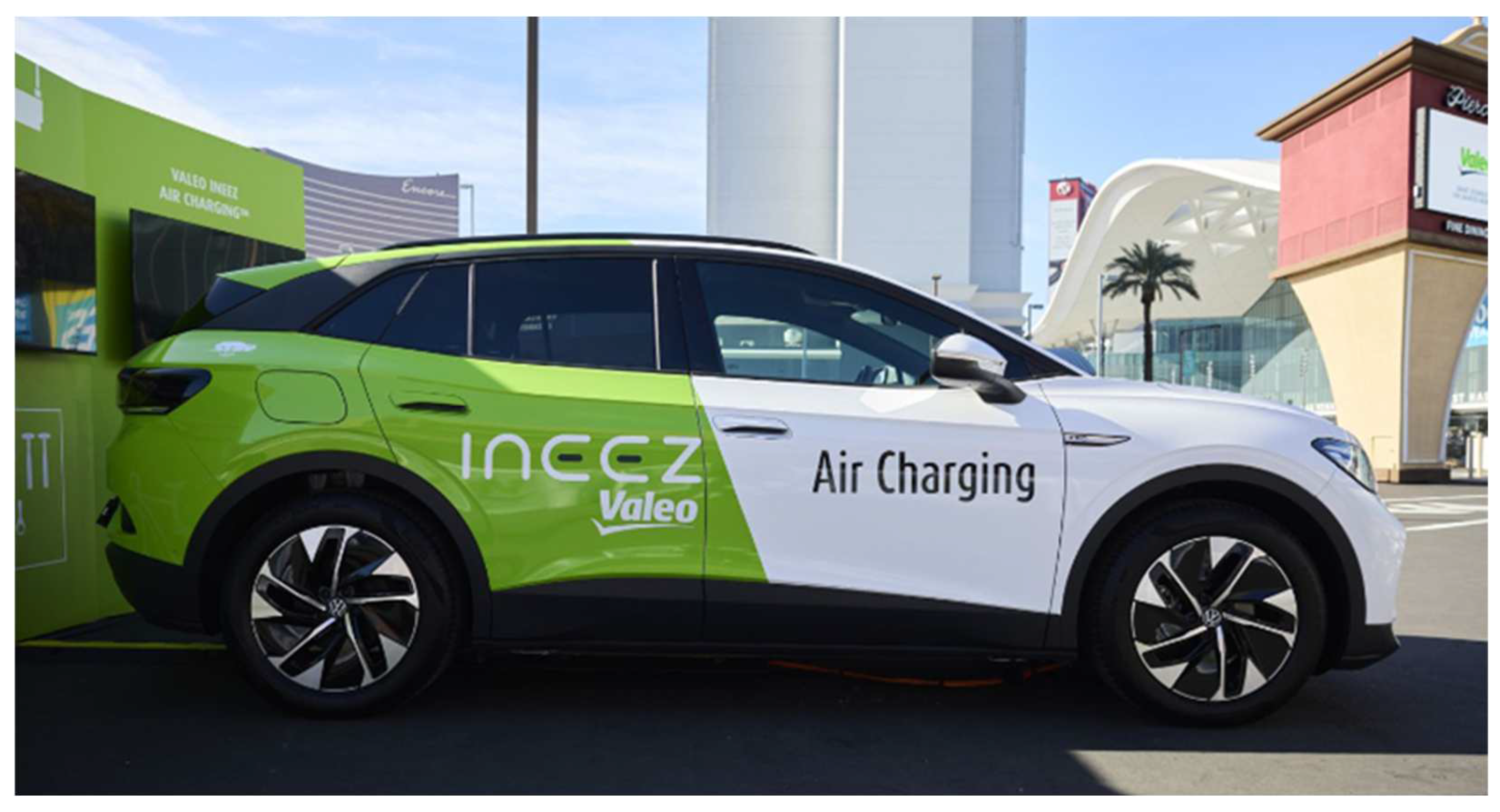
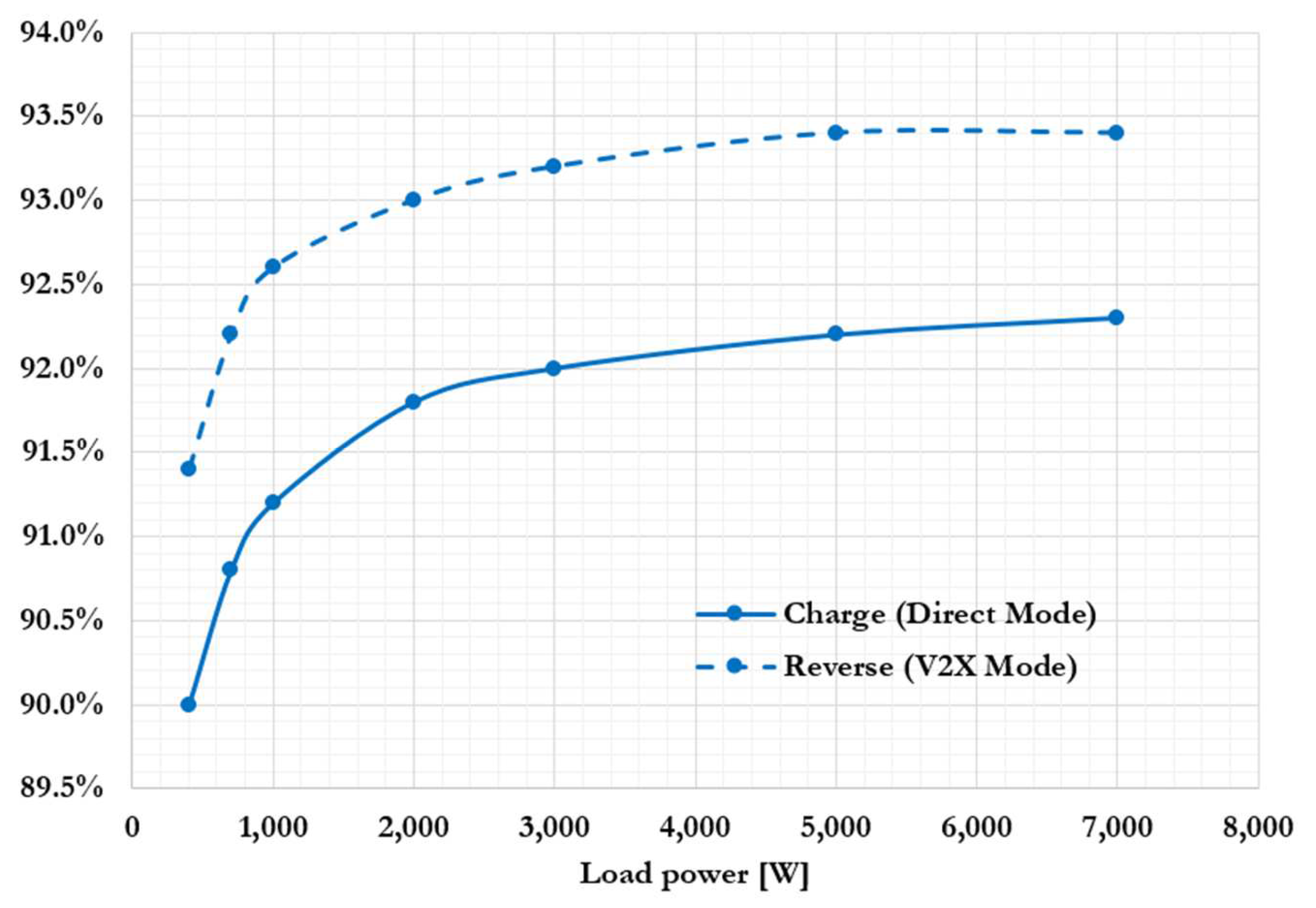

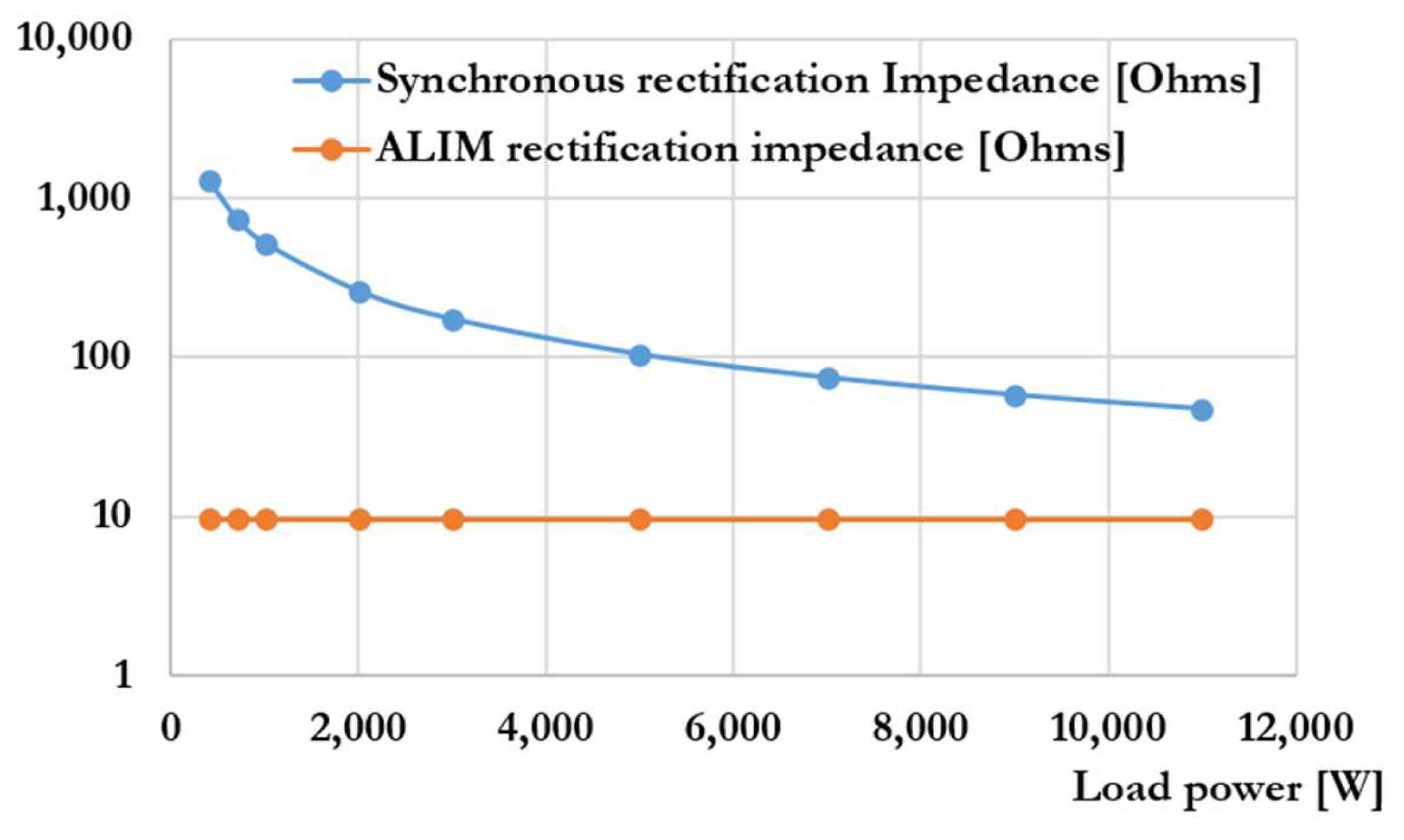



| Attribute | Value |
|---|---|
| Operating frequencies | Fsw = 7 kHz Fadapt = 140 kHz |
| EV-side and charging-station-side transistors | 1200 V 12 mΩ SiC MOSFET |
| Primary capacitor | 390 nF ESR ~5 mΩ at 7 kHz |
| Secondary capacitor | 460 nF ESR ~5 mΩ at 7 kHz |
| Charging station coil | 1.324 mH ESR 587 mΩ at 7 kHz 100 mm airgap Magnetic core + winding total weight 6.8 kg |
| EV-side coil | 1.117 mH ESR 456 mΩ at 7 kHz 100 mm airgap Magnetic core + winding total weight 4.9 kg |
| Coupling factor at 100 mm airgap | 45.5% |
| Total control and driving power | 5 W |
| Attribute | Value |
|---|---|
| Operating frequencies | Fsw = 2.8 kHz Fadapt = 100 kHz |
| EV-side and charging-station-side transistors | 750 V 11 mΩ SiC MOSFET |
| Primary capacitor | 2 µF ESR ~10 mΩ |
| Secondary capacitor | 2.9 µF ESR ~10 mΩ |
| Charging station coil | 1.8 mH ESR 437 mΩ at 2.8 kHz 100 mm airgap Magnetic core + winding total weight 3.7 kg |
| EV-side coil | 1.2 mH ESR 349 mΩ at 2.8 kHz 100 mm airgap Magnetic core + winding total weight 2.3 kg |
| Coupling factor at 100mm airgap | 53.5% |
| Total control and driving power | 5 W |
| Operating Mode → | EV Charging Mode | V2X Mode | |
|---|---|---|---|
| ↓ Control Variables | |||
| Charging station side | Duty cycles αA1/αA2 | 50% | * |
| Duty cycles αB1/αB2 | 50% | * | |
| Phase shift φA | 0 rd | π rd | |
| Phase shift φB | 0 rd | π rd | |
| Phase shift φC | Phase shift power loop control | π/2 rd | |
| Operating frequency | Fsw | Fadapt | |
| EV side | Duty cycles α11/α12 | * | 50% |
| Duty cycles α21/α22 | * | 50% | |
| Phase shift φ1 | π rd | 0 rd | |
| Phase shift φ2 | π rd | 0 rd | |
| Phase shift φ3 | π/2 rd | Phase shift power loop control | |
| Operating frequency | Fadapt | Fsw |
| Attribute | Value |
|---|---|
| Operating frequencies | Fsw = 85 kHz Fadapt = 425 kHz |
| EV-side and charging-station-side transistors | 1200 V 12 mΩ SiC MOSFET |
| ZVS inductors | 2 µH 150 A ESR DC ~1.5 mΩ/425 kHz ~2.25 mΩ |
| ZVS capacitors | 2 nF 1200 V ~5 mΩ at 425 kHz |
| Primary capacitor | 50 nF ESR ~10 mΩ at 85 kHz |
| Secondary capacitor | 23 nF ESR ~10 mΩ at 85 kHz |
| Charging station coil | 154 µH ESR 71.8 mΩ at 85 kHz 100 mm airgap Magnetic core + winding total weight 5.06 kg |
| EV-side coil | 70.5 µH ESR 42.4 mΩ at 85 kHz 100 mm airgap Magnetic core + winding total weight 1.04 kg |
| Coupling factor at 100 mm airgap | 22.6% |
| Total control and driving power | 16.3 W for ALIM rectification/5.4 W for synchronous rectification |
Disclaimer/Publisher’s Note: The statements, opinions and data contained in all publications are solely those of the individual author(s) and contributor(s) and not of MDPI and/or the editor(s). MDPI and/or the editor(s) disclaim responsibility for any injury to people or property resulting from any ideas, methods, instructions or products referred to in the content. |
© 2024 by the author. Licensee MDPI, Basel, Switzerland. This article is an open access article distributed under the terms and conditions of the Creative Commons Attribution (CC BY) license (https://creativecommons.org/licenses/by/4.0/).
Share and Cite
Allali, N. Enhancing Wireless Charging for Electric Vehicles: Active Load Impedance Matching and Its Impact on Efficiency, Cost and Size. Electronics 2024, 13, 2720. https://doi.org/10.3390/electronics13142720
Allali N. Enhancing Wireless Charging for Electric Vehicles: Active Load Impedance Matching and Its Impact on Efficiency, Cost and Size. Electronics. 2024; 13(14):2720. https://doi.org/10.3390/electronics13142720
Chicago/Turabian StyleAllali, Nicolas. 2024. "Enhancing Wireless Charging for Electric Vehicles: Active Load Impedance Matching and Its Impact on Efficiency, Cost and Size" Electronics 13, no. 14: 2720. https://doi.org/10.3390/electronics13142720






